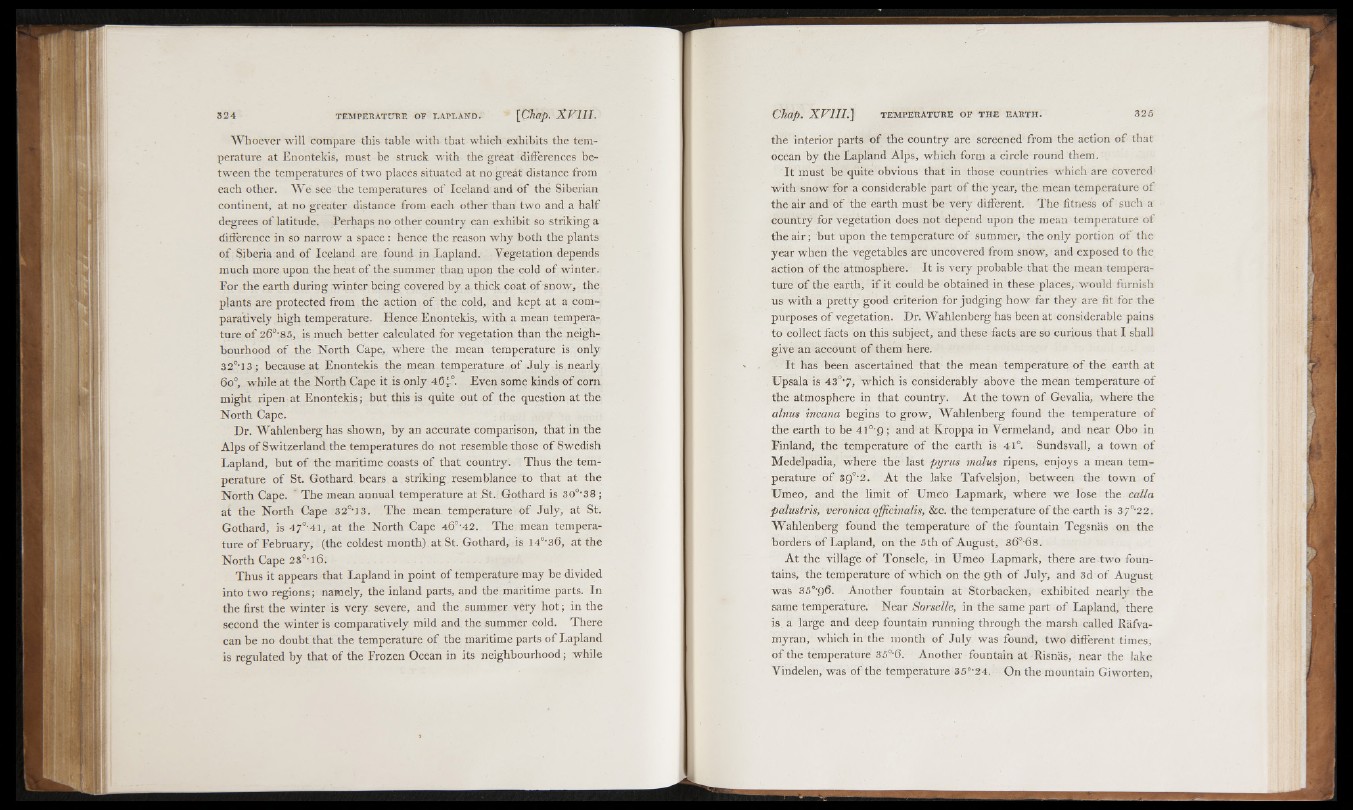
Whoever will compare this table with that which exhibits the temperature
at Enontekis, must be struck with the great differences between
the temperatures o f two places situated at no great distance from
each other. We see the temperatures of Iceland and o f thé Siberian
continent, at no greater distance from each other than two and a half
degrees of latitude. Perhaps no other country can exhibit so striking a
difference in so narrow a space : hence the reason why both the plants
of Siberia and of Iceland are found in Lapland. Vegetation depends
much more upon the heat o f the summer than upon the cold of winter.
For the earth during winter being covered by a thick coat of snow, the
plants are protected from the action of the cold, and kept at a comparatively
high temperature. Hence Enontekis, with a mean temperature
of 260-85, is much better calculated for vegetation than the neighbourhood
of the North Cape, where the mean temperature is only
3 2°' 13 ; because at Enontekis the mean temperature of July is nearly
6o°, while at the North Cape it is only 40 i°. Even some kinds of corn
might ripen at Enontekis ; but this is quite out of the question at the
North Cape.
Dr. Wahlenberg has shown, by an accurate comparison, that in the
Alps of Switzerland the temperatures do not resemble those of Swedish
Lapland, but of the maritime coasts of that country. Thus the temperature
of St. Gothard bears a . striking, resemblance to that at the
North Cape. ' The mean annual temperature at St. Gothard is 30°-38 ;
at the North Cape 3 2°' 13. The mean temperature of July, at St.
Gothard, is 47°-4 1 , at the North Cape 46°'42. The mean temperature
of February, (the coldest month) at St. Gothard, is 140-36, at the
North Cape 23°-16.
Thus it appears that Lapland in point of temperature may be divided
into two regions; namely, the inland parts, and the maritime parts. In
the first the winter is very severe, and the summer vefy hot; in the
second the winter is comparatively mild and the summer cold. There
can be no doubt that the temperature o f the maritime parts of Lapland
is regulated by that of the Frozen Ocean in its neighbourhood ; while
the interior parts of the country are screened from the action of that
ocean by the Lapland Alps, which form a circle round them.
It must be quite obvious that in those countries which are covered
with snow for a considerable part of the year, the mean temperature of
the air and of the earth must be very diffèrent. The fitness o f such a
country for végétation does not depend upon the mean temperature of
the air ; but upon the temperature o f summer, the only portion o f the
year when the vegetables are uncovered from snow, and exposed to the
action o f the atmosphere. It is very probable that the mean temperature
of the earth, i f it could be obtained in these places, would furnish
us with a pretty good criterion for judging how far they are fit for the
purposes o f vegetation. Dr. Wahlenberg has been at considerable pains
to collect facts on this subject, and these facts are so curious that I shall
give an account of them here.
It has been ascertained that the mean temperature o f the earth at
Upsala is 430,7, which is considerably above the mean temperature of
the atmosphere in that country. At the town o f Gevalia, where the
alnus incana begins to grow, Wahlenberg found the temperature of
the earth to be 4 10-g ; and at Kroppa in Vermeland, and near Obo in
Finland, the temperature of the earth is 4 1 °. Sundsvall, a town of
Medelpadia, where the last pyrus malus ripens, enjoys a mean temperature
of 3g°*2 . At the lake Tafvelsjon, between the town of
Umeo, and the limit o f Umeo Lapmark, where we lose the calla
palustris, veronica officinalis, &c. the temperature of the earth is 370-22 .
Wahlenberg found the temperature o f the fountain Tegsnâs on the
borders of Lapland, on the 5 th o f August, 36°'68.
At the village o f Tonsele, in Umeo Lapmark, there are two fountains,
the temperature o f which on the Qth o f July, and 3d of August
was ES^-gS. Another fountain at Storbacken, exhibited nearly the
same temperature. Near Sorselle, in the same part o f Lapland, there
is a large and deep fountain running through the marsh called Ràfva-
myran, which in the month of July was found, two different times,
of the temperature 3 5 °-6 . Another fountain at Risnas, near the lake
Vindelen, was of the temperature 35°'24. On the mountain Giworten,